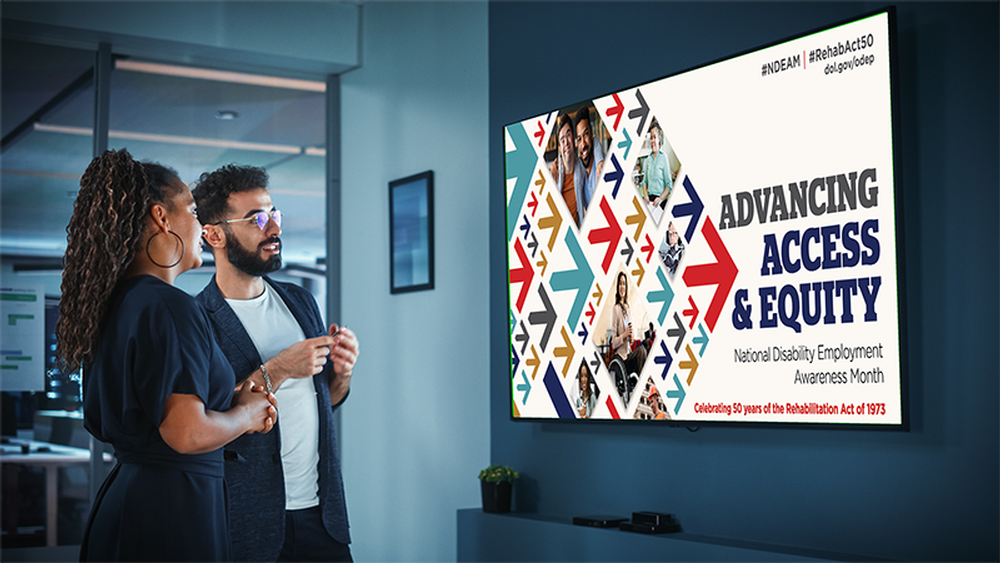
Effective Corporate and Government Digital Signage Using Timely Content
- Gary Potterfield
Categories: audience awareness , communication strategy , content creation , content management , content strategy , corporate communication , digital out of home , digital signage , DOOH , employee communication , external communication , graphic design , information awareness , information relevance , internal communication , multimedia , real-time , relevance , video production
By Gary Potterfield, Managing Director for Operations
At Vox Optima, LLC we work in what I believe is the most challenging communication vertical in signage: the inward-facing corporate and government sectors. More than any other sector, corporate and government signage faces the employee relations challenge of overcoming the monotony of the same eyeballs looking at the same screens every day.
Consider for a moment the difference between digital signage in a major retailer and signage in a corporate atrium. Let’s put aside for a moment the fact that the retail store content probably has a budget that dwarfs that in the employee-facing workspace (we’ll talk about that challenge in the following post).
Let’s consider two pieces of content.
We’ll say that the quality and importance of both are equal. In theory, the first time the customer in the store and the employee in their workplace see the impactful 15-second multimedia piece, they likely act. The customer buys the shoes. The employee takes the required training course. Let’s fast-forward to Day Two.
A new customer sees the piece and buys shoes. The same employee from yesterday sees the piece and says, “Thanks. I took that course yesterday.”
On Day Three, dozens of customers buy shoes. That same employee from yesterday says, “Give me a break. I took the course already!” When Day Five rolls around, the store has run out of inventory, and our busy corporate employee doesn’t even notice the screen anymore.
So, how and why do we ensure effective employee engagement using corporate or government digital signage?
Real-Time Relevance
Timely content means delivering relevant, meaningful content to the right audience, at the right place, at the right time. In corporate communication, this means displaying company and employee news announcements, upcoming meetings, and important employee alerts. Government employee communication and engagement involves real-time delivery of policy updates, emergency notifications, or community event details. Well-timed information displays and programmatic content strategies build employee trust and ensure updated audiences are engaged with the latest developments
Enhanced Engagement
To be a successful digital signage strategy, the critical key element of engagement is essential. As I mentioned above, timely, relevant content captures the audience's attention and encourages message retention and action motivation. We can achieve this with corporate dynamic content highlighting the company’s real-time performance metrics or boosting morale and productivity using employee recognitions and personnel spotlights. Similarly, judicious showcasing of public services, organizational mission and goals, and policy updates to a government employee audience increases engagement, promotes transparency, and builds trust.
Emergency Readiness
In both organizational settings, emergencies occur. Ensuring employee and customer safety is paramount, and having a digital signage system displaying alerts and instructions saves lives. Concise and responsive content can make the difference between emergency management success and costly chaos. Whether it's a fire drill in a corporate building or emergency-related messaging in a government facility, digital signage rapidly delivers critical instructions to all audiences.
Adaptability and Flexibility
Having a dynamic content creation and management strategy ensures your digital signage program keeps your content creators and system programmers in the development process, making your digital signage system adaptable and flexible. This means quickly developing and incorporating new information, which provides all audiences with fresh and relevant content.
For corporate audiences, digital signage strategies mean showcasing the latest sales figures, announcing last-minute meetings, or highlighting employee accomplishments. In government internal information strategies, digital signage might involve updating internal and external audiences on changes in regulations or public services. Content creation flexibility allows information campaign immediacy and adaptability as circumstances and messaging evolve.
Reputation Management
If your messaging is to be credible, then your reputation must be credible, whether as a corporation or a government agency – both of whom are struggling in this area lately. Authentic, credible content helps manage and shape audience and stakeholder perceptions of your organization and those perceptions help the audiences decide whether you are trustworthy or not.
Corporations that share new updates on achievements, quick and honest responses to crises, highlight product launches or demonstrate real community involvement can enhance their reputations. The government can enhance its reputation in a similar fashion by quickly delivering authentic and credible communication regarding new and existing policies, new community initiatives, and rapid, ethical responses to crises. These actions – with the help of strategic digital signage and content – build audience trust and foster a positive image in the eyes of potential new audiences.
Compliance and Regulations
There are certain government and corporate sectors that require adherence and compliance to a variety of informational and accessibility regulations. An effective digital signage strategy includes content development and creation that has these requirements in mind when content is added to the digital system program. This content ensures displayed information meets these requirements. Whether it's sharing compliance guidelines within a corporation or government-mandated public service announcements, accessibility, and formatting are critical for adhering to all legal and ethical standards.
Delivering new, fresh content in the corporate and government verticals is not just about communication; it's about fostering engagement, ensuring safety, and upholding reputation and credibility. As digital signage continues to evolve, incorporating strategies that prioritize timely content will be crucial in maximizing its potential for organizational growth and community well-being.
In a subsequent post, we’ll address how to overcome the challenges of quantity and quality of content creation for this necessary and most challenging vertical.
 +1 (866) 499-2947
+1 (866) 499-2947 